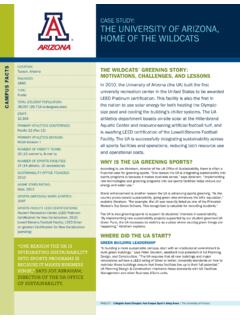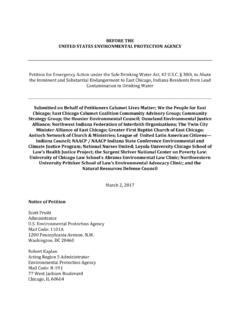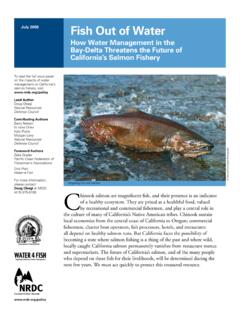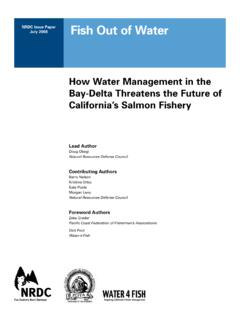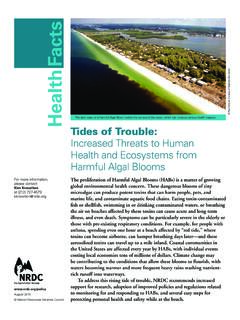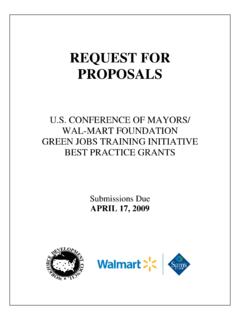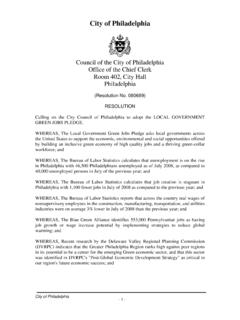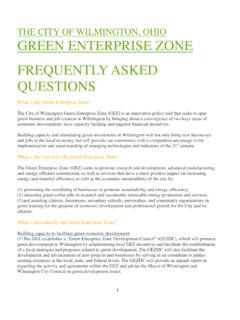Transcription of KAnsAs cIty, mIssouRI - Natural Resources Defense Council
1 KAnsAs city , mIssouRI 1 | Rooftops to Rivers IIKAnsAs city , mIssouRI A CASE STUDY OF HOW green INFRASTRUCTURE IS HELPING MANAGE URBAN STORMWATER CHALLENGEStyPes of green InfRAstRuctuRe useD: green roofs, rain barrels/cisterns, permeable pavement, rain gardens, infiltration trenches or vaults, vegetated swales, street trees, stream buffers, downspout disconnectionKansas city has only recently turned to green infrastructure as a means of reducing stormwater runoff and CSO events. The city broke ground in June 2011 on its first wide-scale pilot project, the Middle Blue River Basin green Solutions Pilot Project. The project will focus on green infrastructure as the sole control for CSOs in a 100-acre residential area of the city s Marlborough neighborhood and will serve as a model for future funding of projects to utilize green infrastructure as a CSO control method.
2 The city had earlier kicked off a 10,000 Rain Gardens initiative in 2005 to encourage residents to voluntarily install rain gardens on their property as a means of reducing stormwater runoff. KAnsAs city also added measures under its CSO Overflow Control Plan to integrate green infrastructure into city planning and to promote preservation and enhancement of green infrastructure in the city as a tool for economic development. The intended approach is based on adaptive management strategies to determine where and how much volume reduction can realistically be achieved. However, funding for initiatives such as future rain gardens and downspout disconnection campaign has been uncertain, the city has yet to offer strong incentive programs for private application of green infrastructure, and it has yet to fully integrate green infrastructure into its long-term planning overall.
3 Hopefully KAnsAs city s initial efforts will serve as a catalyst for further, and more comprehensive, efforts to incorporate the use of green infrastructure into its planning. bAcKGRounDKansas city , mIssouRI , sits at the confluence of the KAnsAs and mIssouRI rivers and is part of a metropolitan area that extends into the state of KAnsAs . Like those of many older cities in the United States, KAnsAs city s sewer systems are aging. Each year, combined sewer overflows discharge billion gallons of untreated effluent, and sanitary sewer overflows discharge another 100 million During large storms, these systems can become overwhelmed by excess water, causing flow volume and bacteria levels to impact surrounding water quality,2 and the sewer systems to reach their conveyance capacity. This increases the likelihood of sewer backup and localized flood events.
4 In 2010, as part of a Clean Water Act settlement, KAnsAs city entered into a consent decree with the EPA to eliminate all discharges from its sanitary sewer system and reduce discharges from CSOs by billion gallons per year by 2025, at an estimated cost of $ KAnsAs city , mIssouRIemeRAlD city cRIteRIA* Existing requirement to use GI to reduce some portion of the existing impervious surfaces? Long-term green Infrastructure (GI) Plan?Retention Standard?n3 Incentives for private-party actions?n3 Guidance or other affirmative assistance to accomplish GI within city ?n3 Dedicated funding source for GI?total criteria score3 Out of a possible 6 KAnsAs city , mIssouRI 2 | Rooftops to Rivers IIThe city submitted an Overflow Control Plan in 2008 under which it would invest $28 million in pilot projects over five years to evaluate the effectiveness of green infrastructure as a widespread, systemic solution to sewer overflows, with allowances for gray infrastructure to be swapped with green if the pilot proved successful.
5 Upon review, the city Council directed the Water Services Department to move ahead with efforts to shift more emphasis onto green solutions,4 and in 2009 the city submitted a plan that budgeted $78 million for green infrastructure projects. In total, the plan includes the $28 million pilot project, plus, upon successful implementation of the pilot, an additional $40 million for green infrastructure controls, $5 million for rain garden and downspout disconnection incentives, and $5 million for green - collar jobs ,5 making it one of the largest municipal green infrastructure projects in the nation to control combined sewer The plan has also budgeted $24 million for the monitoring and modeling necessary to evaluate the success of all project The development of both the Overflow Control Plan and management of stormwater fell under the Wet Weather Solutions Program of KAnsAs city s Water Services Department.
6 Under its 2008 Manual of Best Management Practices for Stormwater Quality, created for the KAnsAs city Metropolitan Area and the Mid-America Regional Council planning region, the city added volume controls and a treatment train approach to stormwater management that serves to filter pollution out of runoff and slow the flow of runoff so it can percolate into the Over the past two years, KAnsAs city has also instituted additional measures in order to incorporate green concepts into the culture of all city operations and achieve the triple bottom line goals of environmental quality, social equity, and economic vitality. Highlights from a stormwater perspective include the adoption of:n a stream buffer ordinance with a minimum 100-foot buffer as measured from the edge of the stream; n a goal to plant an additional 120,000 trees in streetscapes and parks;9 n a green Solutions Policy to integrate green solutions including green infrastructure practices into city planning and development processes;10 andn an Economic Development and Incentives Policy that promotes preservation and enhancement of the city s green infrastructure as tools for economic Lynn Hinkle, ASTRA CommunicationsKansas city s 10,000 Rain Gardens initiative began in 2005 to address existing stormwater and overflow control problems.
7 Its goal is to install 10,000 rain gardens, vegetated swales, and rain barrels in the greater metropolitan city , mIssouRI 3 | Rooftops to Rivers IImIDDle blue RIveR bAsIn PIlot PRoject The first green infrastructure pilot under KAnsAs city s Overflow Control Plan is the 100-acre Middle Blue River Basin green Solutions Pilot Project, located in a largely residential area of the city s Marlborough neighborhood that drains into two combined sewer outfalls. While the city s draft plan of 2008 called for two underground tanks to store and transfer 3 million gallons of overflow from the outfalls, in the final plan these tanks were replaced with at least million gallons of storage through the use of gray and green infrastructure The Marlborough project represents the largest focused installation of green infrastructure as a sole control for CSOs in the nation.
8 As such, its success or failure could have a large impact on other green infrastructure efforts throughout the country. In addition to providing valuable performance data regarding the ability of green infrastructure to reduce combined sewer overflows and stormwater runoff, this pilot will also evaluate socio-economic benefits, assess construction and maintenance techniques and costs, and develop preliminary green design standards for KAnsAs city . The project, which broke ground in June 2011, is scheduled to be completed by The Water Services Department estimates that implementing these green infrastructure practices will potentially save the city $10 million in capital costs, relative to what would have been spent if only gray infrastructure techniques were 10,000 RAIn GARDensKansas city s 10,000 Rain Gardens initiative began in 2005 to address existing stormwater and overflow control issues.
9 Largely, the program s goal was exactly what its name suggests: the installation of 10,000 rain gardens, vegetated swales, and rain barrels in the greater metropolitan area. However, it went beyond that goal to create awareness of the problem in a way that highlights how individuals, businesses, and municipal entities can be part of the solution. It also provided training to city employees, private landscapers, and retailers at a cost of $50 per participant. To keep costs low, the 10,000 Rain Gardens website was used as the primary method for relaying information. In the program s first two years, the group gave 62 rain garden presentations; conducted two media campaigns using TV commercials and appearances, newspaper inserts, and radio ads; and distributed a quarterly electronic newsletter to almost 1,100 people.
10 Through the media campaigns alone, it was estimated that the program reached more than 1 million people in 2006 and more than 3 million in 2007. As a result of these efforts, by July 2008, at the writing of the long-term CSO Control Plan, 303 rain gardens had been registered on the Unfortunately, progress has stalled since then, and efforts to register additional rain gardens have While the Overflow Control Plan itself budgets $5 million for an aggressive rain garden and downspout disconnection campaign,17 the money has yet to flow, leaving the program without capacity. fInAnce stRAteGyKansas city s Wet Weather Solutions Program includes improvements to address wastewater and stormwater problems that occur when it rains. In order to help pay for the burgeoning costs of wet weather management and incentivize the use of green infrastructure, the city created a stormwater utility that began operation in 1999.


